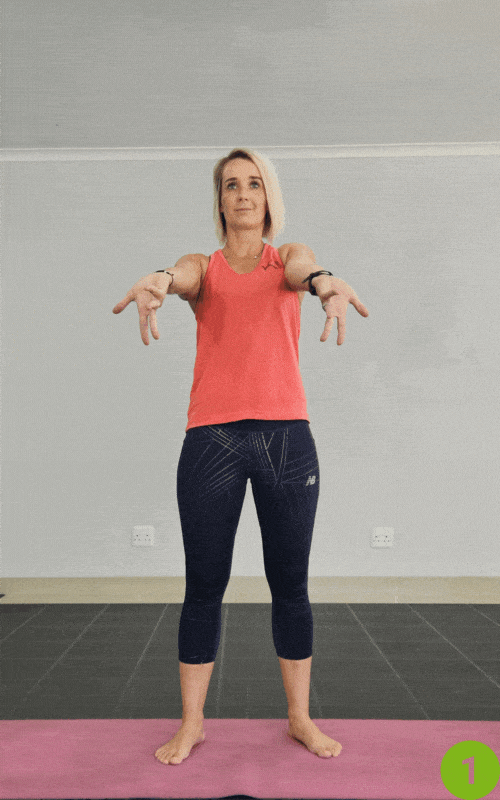Muscular dystrophy [1] refers to a group of muscle diseases that cause progressive weakness and muscle loss, often requiring targeted interventions such as muscular dystrophy stretches to help manage symptoms.
Over time, people with muscular dystrophy may struggle with walking, standing, or performing everyday tasks.
But here’s the good news: regular physical activity—especially tailored muscular dystrophy exercises—can help improve muscle function, support emotional and psychological health, and enhance quality of life.
While exercise won’t reverse muscle damage, it can support strength, flexibility, balance, and mobility over time.
Whether you’re managing Duchenne muscular dystrophy, Becker muscular dystrophy, or myotonic dystrophy type 1, a gentle, consistent exercise program can play a crucial role in maintaining independence.
Always consult with your doctor or physical therapist before starting any routine. Your healthcare provider can help you identify the proper body mechanics and alignment, avoid injury, and monitor fatigue and heart rate during training.
How to Do These Muscular Dystrophy Exercises at Home
These low-impact, therapeutic movements help prevent contractures, maintain muscle strength, and support daily activities like walking, standing, or climbing stairs.
1. Side Twist Wrist Stretch

- Sit upright with arms extended in front.
- Gently twist wrists side to side.
- After that, perform for 10–15 repetitions.
Targets: Wrist, forearm, coordination
2. Seated Finger Extension

- Sit with forearms on your thighs, palms facing down.
- Extend all fingers fully, then gently curl into a relaxed fist
- Again, repeat 10–15 reps.
Targets: Fingers, grip, hand muscles
3. Moving Hand and Wrist Stretch

- Move wrists in circular motions clockwise, then counterclockwise.
- Flex and then extend wrists up and down.
- And then , do this for 30 seconds per direction.
Targets: Hands, wrists, joint mobility
4. Forearm Stretch

- Extend one arm in front, palm up.
- Use the opposite hand to gently pull fingers downward.
- And then, hold 15-30 seconds. Switch arms.
5. Hip Flexor Stretch

- Kneel on your left knee, right foot bent forward.
- Lean slightly forward until you feel a stretch in your right hip.
- After that, hold for 20–30 seconds. Switch sides.
Targets: Hips, posture, lower body strength
6. Hamstring Stretch

- Sit on the chair with one leg extended.
- Reach toward your toes while keeping your back straight.
- Hold 20 seconds. Switch legs.
Targets: Hamstrings, legs, mobility
7. Iliotibial Band Stretch

- Cross the right leg behind the left.
- Lean your torso to the left until you feel a stretch on the outer hip.
- Hold 30 seconds. Switch sides.
Targets: Outer thigh, hips, knee alignment
8. Supine Calf Stretch

- Firstly, lie on your back with one leg raised.
- Loop a towel around your foot and then gently pull toward you.
- Hold 20–30 seconds. Switch legs.
Targets: Calves, ankles, balance
9. Lying Achilles Stretch

Additional Muscular Dystrophy Exercises to Boost Fitness
Aerobic Exercise [3]

- Choose low-impact options like brisk walking, swimming, stationary cycling, or muscular dystrophy stretches.
- Furthermore, aim for 5–10 minutes a day, gradually building up to 20 minutes, 4–6 times a week.
- After that, use the Borg Rating of Perceived Exertion (a scale from 6–20) to monitor workout intensity.
Purpose: Improve cardiovascular health, endurance, and then breathing
Strength Training

- Focus on light weights (5–10 lbs max) or resistance bands with high reps.
- Prioritize muscle strengthening for the upper part of the body and legs.
- In addition, avoid overexertion to reduce the risk of muscle damage.
Purpose: Maintain muscle mass and muscular strength
Stretching Exercises

- Try gentle movements from yoga, Pilates, or Tai Chi.
- After that, hold stretches for 10–30 seconds.
- However, always warm up first to minimize the risk of strain or pain.
Purpose: Enhance flexibility, prevent stiffness, improve joint function
Why Exercise Matters for People with Muscular Dystrophy
For individuals living with muscular dystrophy—especially those with slowly progressive types—movement isn’t just about fitness; it’s a tool to preserve independence and then quality of life.
Benefits of Regular Exercise:
- Muscular dystrophy stretches help maintain muscle strength and then reduce progressive loss.
- Supports mental health [2] and then confidence
- Enhances balance, endurance, and ability to perform daily activities
- Reduces stiffness and then prevents contractures
- In addition, slows the rate of muscle atrophy and helps manage weight
- Using assistive devices, getting guidance from your physical therapist, and customizing your routine will help you exercise safely while supporting your long-term health and muscle function.
“Exercise is critical for individuals with muscular dystrophy—not to build muscle mass in the traditional sense, but to preserve function and slow deterioration. The key is low-intensity, low-impact activity tailored to the individual’s condition. Done properly, exercise can improve endurance, flexibility, and even mental health without worsening muscle damage.” —Dr. Kathryn Wagner, interview with Muscular Dystrophy Association (MDA)
What to Watch Out For
- Don’t ignore signs of fatigue or pain—rest if you feel tired.
- Furthermore, always exercise in the correct position to avoid joint stress.
- In addition, be patient. Benefits such as improved mobility, comfort, and joint range of motion may take weeks.
- After that, consider asking your doctor about ongoing clinical trials or new outcome measures in treatment.
Final Thoughts
A tailored exercise program for muscular dystrophy can be life-changing—helping to preserve independence, reduce complications, and improve overall health.
With the right guidance and routine, including muscular dystrophy stretches, people with muscular dystrophy can move better, feel better, and then live more fully.
Download the Tone & Tighten Dumbbell Workout today and start seeing results—right from home! Easy-to-follow, expert-designed routines to tone muscles, burn fat, and then boost confidence.
Frequently Asked Questions
Can exercise help slow the progression of muscular dystrophy?
Yes—while exercise can’t cure muscular dystrophy, consistent low-impact activity can help maintain muscle strength, improve mobility, prevent contractures, and then support overall health. The right exercise program can slow functional decline and improve mental well-being.
Is it safe for children with Duchenne muscular dystrophy to exercise?
Yes, with professional guidance. Gentle stretching and non-weight-bearing activities such as swimming are often recommended. However, fatigue, pain, or muscle weakness must be closely monitored. Supervised physical activity can enhance function, posture, and then quality of life for children.
What are the best types of exercises for muscular dystrophy?
The best exercises include:
- Stretching exercises to reduce stiffness and then maintain flexibility
- Aerobic activities like swimming, cycling, or walking can help build endurance
- Light strength training [4] to preserve muscle function and then strength without overexertion
- All exercises should be supervised or prescribed by a doctor or physical therapist familiar with the specific type of muscular dystrophy.


